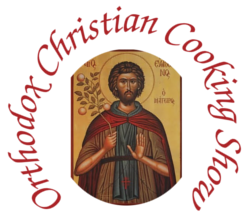In the Orthodox Church a leavened bread called prosphora is used for the celebration of the Divine Liturgy (Eucharist). The word “Prosphora” comes from Greek and it means offering.
Besides the ingredients for the dough to make the prosphora you will also need a Prosphora Seal (different varieties available from eBay), round cookie cutters, rolling pin.
Prospora Using Sourdough Starter
Recipe Type: Church Use (Divine Liturgy)
Author:
Prep time:
Cook time:
Total time:
Serves: Multitudes
This is a recipe for making Prosphora, using sourdough starter as leavening agent. If you do not have large enough dough mixer you can divide this recipe in half.
Ingredients
- 2 cups of water
- 1/2 cup of sourdough starter
- 6 cups of flour
- pinch of slat
Instructions
- mix water and sourdough starter until the starter is disolved
- add flour and mix in the mixer for about 15 minutes after the dough comes together into one ball- the dough must be very stiff but silky smooth at the same time.
- set the dough to rise for about 12 hours
- roll out the dough to about 1/2 inch thickness and cut the bottoms of prosphora with a 2 3/4 inches round cookie cutter, placing all the bottoms into baking sheet to rise for about 30-40 minutes.
- kneed the remaining dough, form a ball and then roll out to about 1/4 of an inch thickness
- cut the tops of prosphora with a 2 inch round cookie cutter, match the number of tops to the number of bottoms
- using a prosphora seal, press into each top the seal so that bears clearly the imprint of the lettering (or some times and icon) and let the tops rise for 15-20 minutes.
- once the dough rested/risen for about 30-40 minutes place the tops of the prosphora over the bottoms with the imprint facing up – be generous when spraying your prosphora with water (see the video above)
- pierce each prosphora with a wire (unfolded paper clip) in the form of the cross + as many times as you thing there is need for – piercing the prosphora helps to control the “oven spring” so that it rises equally when it is baking in the oven
- bake at 550℉ for 12 minutes, checking and spraying your prosphora with water half way
- (NOT IN THE VIDEO) To cool your prosphora – set it on the cooling rack then cover it with a dry towel, a wet towel and again with dry towel. Allow to cool for 3 hours before freezing.


Comments on this entry are closed.
Your Phosphora looks great.
I din’t know about the water spray.
Now; can you show us an easier way
to make rhe regular Phophora.
Just one round loaf.
I do make it and toughted others how to,
but I tend to press to hard on the seal
and end up with a sunken middle.
PS: I did missed your shows.
Tita, I might consider trying to show how to make the large Greek style prosphora… I have never made one before. I am considering making another prosphora video with just regular yeast.
Thank you for posting this video! I have been experimenting with sourdough prosphora in the Greek tradition for the past year, but I was not happy with the results. After baking other lean and drier types of sourdough bread I was ready to try prosphora again after watching your excellent video. I stayed with a little less than 50% hydration in my sourdough preferment and used 10 ounces of it in a 55 ounce recipe – then added my remaining water and high protein flour at a little less than 50% hydration along with a tsp of salt….2 minutes of mechanical kneading, and 10-11 minutes of hand kneading. After the 11-12 hour bulk fermentation the dough had excellent strength and the correct amount of firmness. I used an ounce or two of additional flour when kneading to remove air bubbles. As instructed by my priest I did not spray the loaves with water, but kept my three 18 ounce loaves very dry. The end result was acceptable to the standard requested by our priest with a very clear seal. Thank you Father for taking the time to make this video and for your clear instructions. Hopefully there can be better resources like this for those who enjoy bread making but are intimidated by the high requirements for prosphora/antidoron.
Gregory,
Thank you very much for your comment. I am in love so much with the sourdough prosphora that I rarely use regular yest anymore.
50% hydration is a little too “stiff” of a starter for my liking, i keep my starter at 100-125% hydration. The hydration of the dough is hard to tell because I mix the dough without measuring exactly the flour, but simply by feeling it.
The reason I spray my dough during the baking is the high baking temperature- I bake my prosphora at 550 Fahrenheit- this prevents the crust from drying to fast.
I also have addressed few issues/comments regarding the sourdough prosphora on my personal blog:
http://www.volodymyrzablotskyy.com/2014/07/25/few-thoughts-about-prosphora/
Thank you for your comments and happy baking! 🙂
Yes, I bake my bigger loaves at 350 degrees on the upper rack for around 30 minutes — that is a major difference in making the small vs. bigger loaves. I can see why moistening the dough thoroughly would be necessary with just a fast bake.
I do keep my starter at 100% hydration, but a day or two before baking I make a 50% preferment and refrigerate until I am ready to bake. It is an extra step that I am not sure is entirely necessary with a 12 hour fermentation, but it is what I am used to now. I get reliable oven spring with this method.
I will check out the blog as well. Thank you Father.